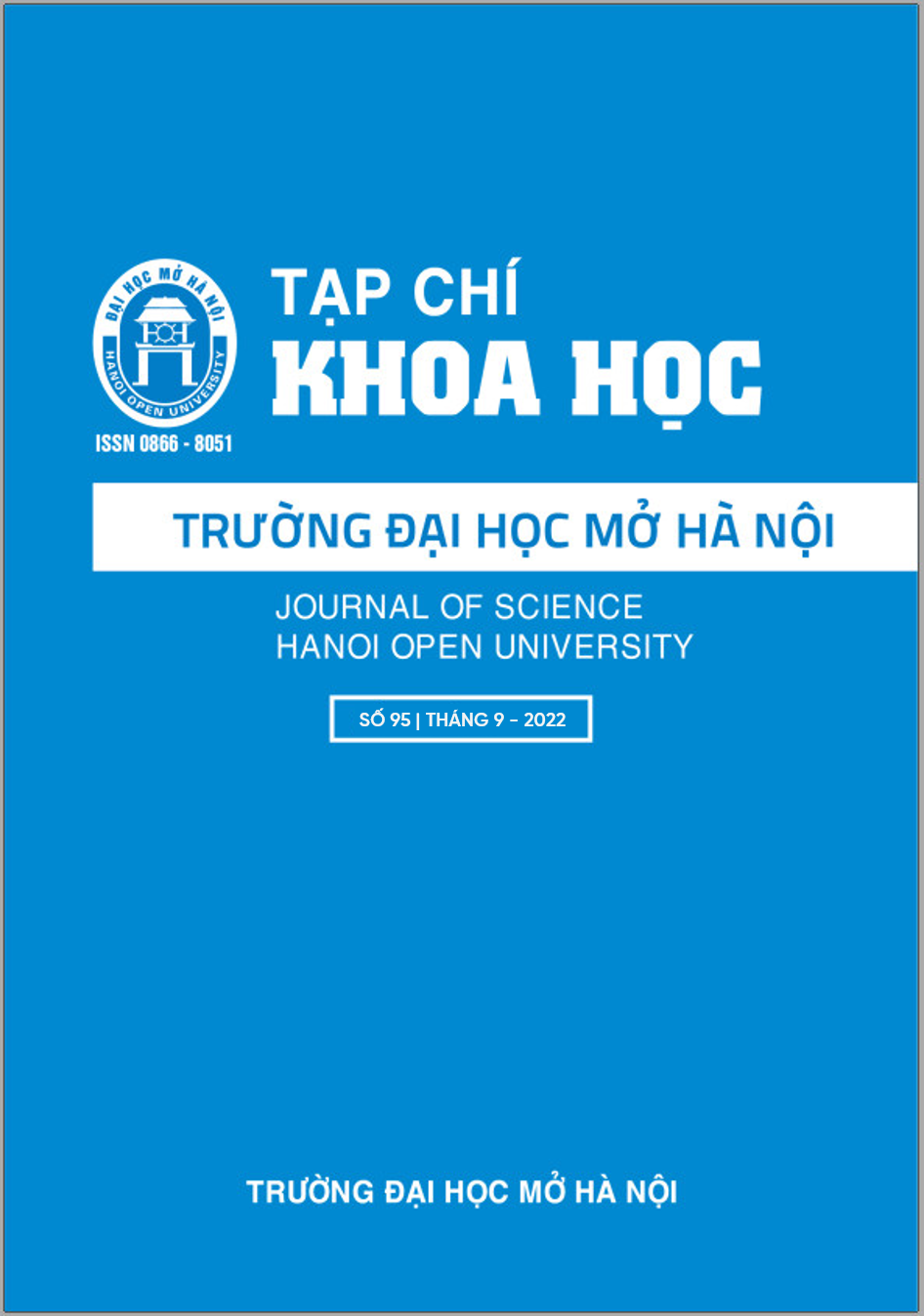STUDY ON BIOLOGICAL CHARACTERISTICS OF ACTINOMYCETE STRAIN CH9.4 ISOLATED FROM CROPLAND IN QUOC OAI DISTRICT, HANOI
Keywords:
antibiotics, actinomycetes, StreptomycesAbstract
In the soil environment, Streptomyces often make up a major proportion of the total actinomycete population and are recognized as a rich source of useful bioactive compounds. Actinomycete strain CH9.4 was isolated from cropland in Quoc Oai district, Hanoi showed high biological activity as resistance to both Gram-negative and gram-positive bacteria, and good growth on a variety of culture media at different temperatures. Optimum growth of CH9.4 strain is 28OC, pH 7.5. Based on the biological characterization study and analysis of the 16S rDNA gene sequence, CH9.4 strain has a high similarity with Streptomyces cinnamonensis strain, hence the name S. cinnamonensis CH9.4. Analysis of the presence of functional genes involved in antibiotic biosynthesis showed that the strain S. cinnamonensis CH9.4 carried the gene encoding polyketide type 2. Thus, the strain S. cinnamonensis CH9.4 has a high potential for research. biosynthesis of antibiotics from microorganisms.
References
[1]. R. Müller, J. Wink , Future potential for anti-infectives from bacteria—How to exploit biodiversity and genomic potential. Int. J. Med. Microbiol, 304:3–13, (2014) .
[2]. Y. Widyastuti, P. Lisdiyanti, S. Ratnakomala, G. Kartina, R. Ridwan, R.Rohmatussolihat, N. Rosalinda Prayitno, E. Triana, N. Widhyastuti, et. al., Genus diversity of Actinomycetes in Cibinong Science Center, West Java, Indonesia, Microbiol, 6:165–172, (2012).
[3]. X. Lucas, C. Senger, A. Erxleben, B.A. Grüning, K. Döring, J. Mosch, S. Flemming, S. Günther, StreptomeDB: A resource for natural compounds isolated from Streptomyces species. Nucleic Acids Res, 41:D1130–D1136, (2013).
[4]. M. Igarashi, Y. Takahashi, T. Shitara, H. Nakamura, H. Naganawa, T. Miyake, Y. Akamatsu, Caprazamycins, novel lipo- nucleoside antibiotics, from Streptomyces sp, J. Antibiot, 58:327–337, (2005).
[5]. S. Dutta, B. Basak, B. Bhunia, S. Chakraborty, A. Dey, Kinetics of rapamycin production by Streptomyces hygroscopicus MTCC 4003. 3 Biotech, 4:523–531, (2014).
[6]. L. Rodríguez, D. Rodríguez, C. Olano, A.F. Braña, C. Méndez, J.A. Salas, Functionalanalysis of OleY L-oleandrosyl 3-O-methyltransferase of the oleandomycin biosynthetic pathway in Streptomyces antibioticus, J. Bacteriol., 183:5358–5363, (2001).
[7]. M. Elibol, Optimization of medium composition for actinorhodin production by Streptomyces coelicolor A3(2) with response surface methodology, Process Biochem, 39:1057–1062, (2004).
[8]. A.R. Pokhrel, A.K. Chaudhary, H.T. Nguyen, D. Dhakal, T.T. Le, A. Shrestha, K. Liou, J.K. Sohng, Overexpression of a pathway specific negative regulator enhances production of daunorubicin in bldA deficient Streptomyces peucetius ATCC 27952, Microbiol. Res., 192:96–102, (2016).
[9]. B.S. Moore, J.N. Hopke, Discovery of a new bacterial polyketide biosynthetic pathway, ChemBioChem, 2:35–38, (2001). [10]. J.S. Rokem, A.E. Lantz, J. Nielsen, Systems biology of antibiotic production by microorganisms, Nat. Prod. Rep., 24:1262, (2007).
[11]. Y. Katsuyama, N. Funa, I. Miyahisa, S. Horinouchi, Synthesis of unnatural flavonoids and stilbenes by exploiting the plant biosynthetic pathway in Escherichia coli, Chem. Biol, 14:613–621, (2007).
[12]. I. Chopra, M. Roberts, Tetracycline antibiotics: Mode of action, applications, molecular biology, and epidemiology of bacterial resistance tetracycline antibiotics: Mode of action, applications, molecular biology, and epidemiology of bacterial resistance, Microbiol. Mol. Biol. Rev., 65:232–260, (2001).
[13]. M.A. Ghannoum, L.B. Rice, Antifungal agents: Mode of action, mechanisms of resistance, and correlation of these mechanisms with bacterial resistance, Clin. Microbiol. Rev., 12:501–517, (1999).
[14]. O. Tacar, P. Sriamornsak, C.R. Dass, Doxorubicin: An update on anticancer molecular action, toxicity and novel drug delivery systems, J. Pharm. Pharmacol., 65:157–170, (2013).
[15]. M.A.M. Shushni, R. Singh, R. Mentel,
U. Lindequist, Balticolid: A new 12-membered macrolide with antiviral activity from an Ascomycetous fungus of marine origin, Mar. Drugs, 9:844–851, (2011).
[16]. J. Li, S.G. Kim, J. Blenis, Rapamycin: One drug, many effects, Cell Metab, 19:373– 379, (2014).
[17]. N.W.C.J. Van de Donk, M.M.J. Kamphuis, H.M. Lokhorst, A.C. Bloem, The cholesterol lowering drug lovastatin induces cell death in myeloma plasma cells, Leukemia, 16:1362–1371, (2002).
[18]. H. Nomomura, Key for classification and identification of 458 species of the Streptomyces included in ISP, J. Ferment. Technol. 52(2) (1974) 78.
[19]. W. Wilkins, Bergey’s Manual of Systematic Bacteriology, Vol. 2, Vol. 3, Vol. 4. Publisher Springer- Verlag, NY, (1989).
[20]. E. Shirling and G. D. Gottlieb, Methods for characterization of Streptomyces species, Int J Syst Bacteriol, vol. 16, pp. 313-340, (1966). [21]. H.D. Tresner , E.J. Buckus,, System of color wheels for Streptomyces taxonomy, Appl Environ Microb 11: 335–338, (1963). [22]. Stanley T. Williams M. E. Sharpe, J.
G. Holt, Bergey’s Mannual of Systematic bacteriology, Williams & Wilkins, 4: 2452- 2492, (1989).
[23]. J. Sambrook , D. Russell, Molecular Cloning: a Laboratory Manual, 3rd. Cold Spring Harbor, NY: Cold Spring Harbor Laboratory, (2001).
[24]. M.K. Mikko, S. Virpi, H. Laura, H. Anne, H. Juha, M. Pekka, Y. Kristiina, An efficient approach for screening minimal PKS genes from Streptomyces, FEMS Microbiol Lett 180: 1-6, (1999)
[25]. B. Sirisha, R. Harith, J. Mohan, K. Siva, K. S. Kumar, and T. Ramana, Bioactive compounds from marine actinomycetes isolated from the sediments of bay of Bengal, IJPCBS, vol. 3, no. 2, pp. 257-264, (2013).
[26]. Kumar S., Stecher G., Li M., Knyaz C., and Tamura K., MEGA X: Molecular Evolutionary Genetics Analysis across computing platforms. Molecular Biology and Evolution 35:1547-1549, (2018).
